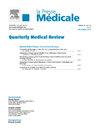Theragnostic approach of venous malformations in 2025: Similarities and differences with oncology advances
IF 3.4
3区 医学
Q1 MEDICINE, GENERAL & INTERNAL
引用次数: 0
Abstract
Background
VMs are congenital vascular anomalies are often the result of genetic mutations. Advances in genetics have revealed that certain Venous malformations (VMs) share mutations with cancers, specifically in the PI3K/AKT/mTOR proliferative pathways. This discovery has paved the way for targeted treatments, similar to those used in oncology. We aim to explore differences between VMs and cancers, particularly in therapeutic and diagnostic approaches.
Material and methods
We performed a systematic review of literature, up to June 2024. Articles has been classified in 3 topics: Clinical advances and prospects; Genomic concern and proliferation pathway and Therapeutics and issues: neoadjuvant strategy, adjuvant strategy. The primary outcome was to make comparison between issues in oncology and VMs.
Discussion
We identified genetic implications as, in some hereditary cases of VMs, the "two-hit" mechanism involves both a germline and a somatic mutation in the same gene, resulting in loss of function and the manifestation of the malformation. Regarding the Therapeutic Strategies and Comparison with Oncology, adjuvant and neoadjuvant seem to be promising in VMs. Lastly, treatment acceptability is a key issue for VM patients: tolerance to the side effects of anticancer drugs used for VMs is a major concern.
Conclusion
Wile VMs and cancers share some proliferative pathways and therapeutic targets, they differ in their growth dynamics and impact on surrounding tissues. The management of VMs is increasingly approached as a “chronic disease,” similar to oncology, but the benefit-risk balance and quality of life remain specific concerns.
2025年静脉畸形的治疗方法:肿瘤学进展的异同。
背景:VMs是先天性血管异常,通常是基因突变的结果。遗传学的进展表明,某些静脉畸形(vm)与癌症共享突变,特别是在PI3K/AKT/mTOR增殖途径中。这一发现为靶向治疗铺平了道路,类似于肿瘤治疗。我们的目标是探索VMs和癌症之间的差异,特别是在治疗和诊断方法方面。材料和方法:我们对截至2024年6月的文献进行了系统综述。文章分为3个主题:临床进展与展望;基因组关注和增殖途径以及治疗方法和问题:新辅助策略,辅助策略。主要结果是比较肿瘤学和VMs的问题。讨论:我们确定了遗传意义,因为在一些vm的遗传病例中,“双重打击”机制涉及同一基因的种系和体细胞突变,导致功能丧失和畸形的表现。关于治疗策略和与肿瘤学的比较,辅助和新辅助治疗VMs似乎很有前景。最后,治疗可接受性是VM患者的一个关键问题:对用于VM的抗癌药物副作用的耐受性是一个主要问题。结论:虽然VMs和肿瘤有一些共同的增殖途径和治疗靶点,但它们在生长动力学和对周围组织的影响方面存在差异。VMs的管理越来越被视为一种“慢性疾病”,类似于肿瘤学,但利益-风险平衡和生活质量仍然是特别关注的问题。
本文章由计算机程序翻译,如有差异,请以英文原文为准。
求助全文
约1分钟内获得全文
求助全文
来源期刊

Presse Medicale
医学-医学:内科
自引率
3.70%
发文量
40
审稿时长
43 days
期刊介绍:
Seule revue médicale "généraliste" de haut niveau, La Presse Médicale est l''équivalent francophone des grandes revues anglosaxonnes de publication et de formation continue.
A raison d''un numéro par mois, La Presse Médicale vous offre une double approche éditoriale :
- des publications originales (articles originaux, revues systématiques, cas cliniques) soumises à double expertise, portant sur les avancées médicales les plus récentes ;
- une partie orientée vers la FMC, vous propose une mise à jour permanente et de haut niveau de vos connaissances, sous forme de dossiers thématiques et de mises au point dans les principales spécialités médicales, pour vous aider à optimiser votre formation.
 求助内容:
求助内容: 应助结果提醒方式:
应助结果提醒方式:


